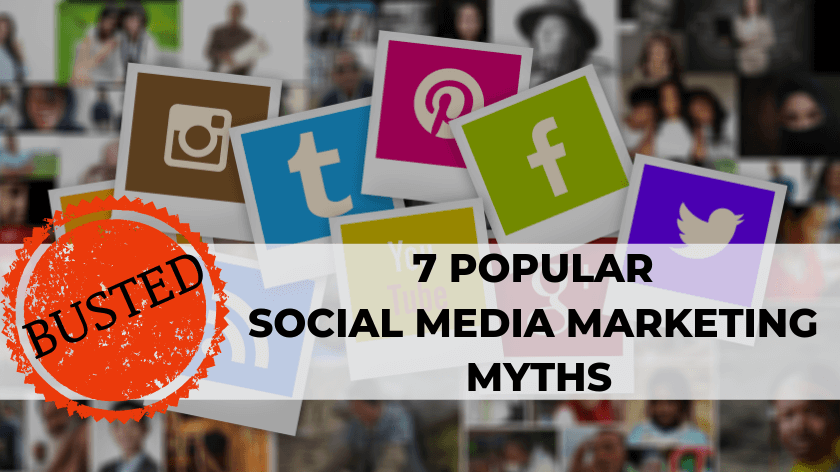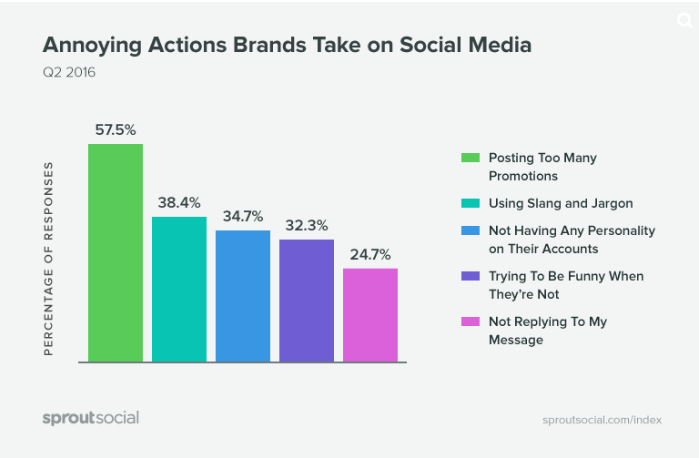
Busted: 7 Popular Social Media Marketing Myth
With great and powerful tools, come popular myths. Myths popular enough to adversely affect decisions. Social media is no exception. As a marketer, I have come across several clients and prospects eager to adopt social media. Yet they hesitate because of some pre-conceived notions. More so, I met many people who despite having a social media presence are unable to harness its true power because of such myths. So, without further ado, let’s get started and bust some of the popular social media marketing myths.
#1: Social Media Marketing comes cheap/free
Fact:
Many businesses often fall for this only to feel disappointed with results. When someone says social media marketing is cheap, the word ‘relatively’ is often silent. Yes, a social media ad campaign may not cost as much as running 30-sec ads on prime-time slots on television. Or putting up a hoarding at a location right in the centre of the city. But it still is some cost when you’re planning it at that huge a scale.
For instance, a car brand is introducing a new model in the UAE. They want to reach out to people within 20-40 years of age interested in adventure and travel. Their aim is to generate about 50,000 visits to their landing page from the target audience in a month. It would cost about AED 40,000 on Facebook to do so.
See, told you, not as expensive as a TV commercial or hoarding, but not a small amount either.
The point here is not to deter you from social media marketing, but to inform you about the scale of the budget involved and help set up realistic expectations from your budget and efforts.
#2: Social Media Marketing is not for B2B
This is as far from the truth as it can be. Point in case – a study by Accenture shows that ‘71% of B2B executives say customers increasingly want B2C-like experiences compared to a few years ago.
Irrespective of what you’re selling, the sales process is pretty much the same, isn’t it? Also, a B2B customer is also a B2C customer. The key to a successful B2B social media strategy is identifying the right social platform, deploying the right set of content to the right set of audiences and driving engagement. So, if you still think, social is only for B2C, think again.
#3: Now that I am on social media, I must constantly talk about my products/services
Fact:
Well, if there was an iota of truth in this notion, no flyer or leaflet ever distributed would have gone waste. The idea of social media is to establish communication with your audiences, not bombard them with promotional messages.
And this is not to say that you should completely abstain from speaking about your offerings, this is your brand page after all. But your brand page isn’t your company brochure.
So, indulge in content marketing. Share content that’s RELATED to your business but isn’t necessarily ABOUT your business. Content that adds value to and connects with an audience is the best form of content.
And while we’re at it, here’s a little study from Sprout Social depicting annoying actions that brands take on social media. Of all things that put off an audience, posting too many promotions, in simple words, talking too much about own brand/product/service tops the chart.

#4: More Followers = More Success
Fact:
This is one trap many small businesses and businesses new to social media fall for. There’s nothing wrong in chasing a significant follower count, in fact for small or local businesses it often adds to their credibility.
However, a mere follower count doesn’t signify much. You may have hundreds of thousands of followers, but if the page isn’t active or isn’t driving enough engagement, the follower count is just that – numbers.
Read more on how you can use digital channels to engage customers.
#5: You can post any time of the day on social media
Fact: This is as popular as a social media marketing myth goes. Far from this myth, you should study your audience’s behaviour and see when they are online or when they engage with your content. The ‘insights’ tab of your Facebook page can furnish you with information. Or you can refer to several other social media tools. Understanding when your audience is online can help you post at the optimum time to drive most engagement.
Similarly, you can deploy some test ads at nominal budgets across various times of the day to see which time slot gets you most engagement. Identify that slot and post accordingly.
It takes a fair bit of time and effort to come up with a post that you want to share with your audience. The last thing you want to do is post at such a time when no one interacts with it.
#6: You can post as many times as you like on social media
Just as there is an optimum time to post your content, similarly there is only an optimum number of times to post during the day. Several studies point that engagement rates drop on Facebook and LinkedIn when you post more than once per day. However, it makes sense to share multiple posts on twitter owing to the shorter shelf life of a tweet.
To put things into a perspective, we all love to see what our friend is up to when they go on a vacation and share pictures from the trip. However, when the frequency of their posts increases, one does feel a tad bit bugged, isn’t it?
Remember, your audience may want to hear from you but does not want to get spammed by you.
#7: An active social media or a sound social strategy alone will ensure sales
Fact: No, it won’t. Think of social media as a promoter who can get people to walk into the store. The eventual purchase/transaction happens in the store which is dependent on various factors like quality of the products, feel a visitor gets in the store, service offered by the store manager, etc.
Likewise, social media can at best drive people to your website. The eventual conversion must happen on your website which depends on the speed, UI, functionality, etc of the website. So social media is not a stand-alone marketing component but needs integration with overall marketing strategy.
Well, that’s some of the social media marketing myths busted. Did I miss any? Do let me know in the comments below.
Need help with social media marketing or digital efforts? Contact us!

